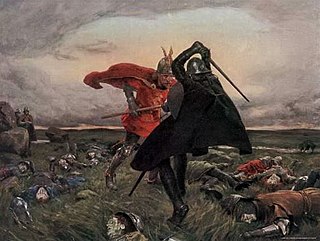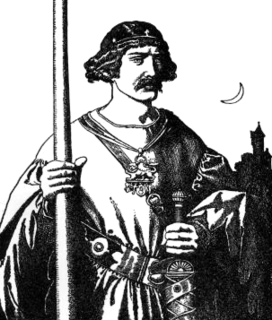Related Research Articles
Annwn, Annwfn, or Annwfyn is the Otherworld in Welsh mythology. Ruled by Arawn, it was essentially a world of delights and eternal youth where disease was absent and food was ever-abundant. It became identified with the Christian afterlife in paradise.

The Mabinogion are the earliest Welsh prose stories, and belong to the Matter of Britain. The stories were compiled in Middle Welsh in the 12th–13th centuries from earlier oral traditions. There are two main source manuscripts, created c. 1350–1410, as well as a few earlier fragments. The title covers a collection of eleven prose stories of widely different types, offering drama, philosophy, romance, tragedy, fantasy and humour, and created by various narrators over time. There is a classic hero quest, "Culhwch and Olwen"; a historic legend in "Lludd and Llefelys," complete with glimpses of a far off age; and other tales portray a very different King Arthur from the later popular versions. The highly sophisticated complexity of the Four Branches of the Mabinogi defies categorisation. The stories are so diverse that it has been argued that they are not even a true collection.
Aneirin[aˈnɛirɪn], Aneurin or Neirin was an early Medieval Brythonic war poet. He is believed to have been a bard or court poet in one of the Cumbric kingdoms of the Hen Ogledd, probably that of Gododdin at Edinburgh, in modern Scotland. From the 17th century, he was usually known as Aneurin.

The Battle of Camlann is the legendary final battle of King Arthur, in which Arthur either died or was fatally wounded while fighting either with or against Mordred, who also perished. The original legend of Camlann, inspired by a purportedly historical event said to have taken place in Britain in 537, appears only in vague mentions found in several medieval Welsh texts dating since around the 10th century. The battle's much more detailed depictions have emerged since the 12th century, generally based on that of a catastrophic conflict described in the pseudo-chronicle Historia Regum Britanniae. The further greatly embellished variants originate from the later French chivalric romance tradition in which it became known as the Battle of Salisbury. These include the telling in Le Morte d'Arthur that remains popular today.
Morfran is a figure in Welsh mythology. Usually portrayed as a warrior under King Arthur, he is noted for the darkness of his skin and his hideousness. He appears in the narratives about the bard Taliesin and in the Welsh Triads, where he is often contrasted with the angelically handsome Sanddef.

The Welsh Triads are a group of related texts in medieval manuscripts which preserve fragments of Welsh folklore, mythology and traditional history in groups of three. The triad is a rhetorical form whereby objects are grouped together in threes, with a heading indicating the point of likeness; for example, "Three things not easily restrained, the flow of a torrent, the flight of an arrow, and the tongue of a fool."

Welsh mythology consists of both folk traditions developed in Wales, and traditions developed by the Celtic Britons elsewhere before the end of the first millennium. As in most of the predominantly oral societies Celtic mythology and history were recorded orally by specialists such as druids. This oral record has been lost or altered as a result of outside contact and invasion over the years. Much of this altered mythology and history is preserved in medieval Welsh manuscripts, which include the Red Book of Hergest, the White Book of Rhydderch, the Book of Aneirin and the Book of Taliesin. Other works connected to Welsh mythology include the ninth-century Latin historical compilation Historia Brittonum and Geoffrey of Monmouth's twelfth-century Latin chronicle Historia Regum Britanniae, as well as later folklore, such as the materials collected in The Welsh Fairy Book by William Jenkyn Thomas (1908).
Rhun ap Maelgwn Gwynedd, also known as Rhun Hir ap Maelgwn Gwynedd, sometimes spelt as 'Rhûn', was King of Gwynedd. He came to the throne on the death of his father, King Maelgwn Gwynedd. There are no historical records of his reign in this early age. A story preserved in both the Venedotian Code and an elegy by Taliesin says that he waged a war against Rhydderch Hael of Alt Clut and the kings of Gododdin or Manaw Gododdin. The small scattered settlement of Caerhun in the Conwy valley is said to be named for him, though without strong authority. Rhun also appears in several medieval literary stories, as well as in the Welsh Triads. His wife was Perwyr ferch Rhûn "Ryfeddfawr" and their son was Beli ap Rhun "Hîr".

Sir Ywain, also known as Yvain and Owain among other spellings, is a Knight of the Round Table in Arthurian legend, wherein he is often the son of King Urien of Gorre and the sorceress Morgan le Fay. The historical Owain mab Urien, on whom the literary character is based, was the king of Rheged in Great Britain during the late 6th century.
The Battle of Arfderydd was fought, according to the Annales Cambriae, in 573. The opposing armies are variously given in a number of Old Welsh sources, perhaps suggesting a number of allied armies were involved. The main adversaries appear to have been Gwenddoleu ap Ceidio and either the princely brothers Peredur and Gwrgi or King Riderch Hael of Strathclyde. Gwenddoleu was defeated and killed. His bard, Myrddin Wyllt, went mad and ran into the forest. He is probably the origin of the Arthurian character Merlin. The Welsh Triads refer to this battle as one of the "Three Futile Battles of the Island of Britain", along with the Battle of Camlann and the Battle of the Trees.

Yr Hen Ogledd, in English the Old North, is the historical region which is now Northern England and the southern Scottish Lowlands that was inhabited by the Brittonic people of sub-Roman Britain in the Early Middle Ages. Its population spoke a variety of the Brittonic language known as Cumbric which is closely related to, if not a dialect of Old Welsh. The people of Wales and the Hen Ogledd considered themselves to be one people and both were referred to as Cymry ('fellow-countrymen') from the Brittonic word combrogi. The Hen Ogledd was distinct from the parts of North Britain inhabited by the Picts, Anglo-Saxons, and Scoti.
Gwallog ap Lleenog was a hero of the Hen Ogledd. He has long been considered a probable sixth-century king of the sub-Roman state of Elmet in the Leeds area of modern Yorkshire, though some more recent scholarship would identify him more tentatively simply as a 'king of an unidentified region in the north'.

The Dream of Rhonabwy is a Middle Welsh prose tale. Set during the reign of Madog ap Maredudd, prince of Powys, its composition is typically dated to somewhere between the late 12th through the late 14th century. It survives in only one manuscript, the Red Book of Hergest, and has been associated with the Mabinogion since its publication by Lady Charlotte Guest in the 19th century. A diplomatic version of the text is published by the University of Wales Press as Breuddwyt Ronabwy, edited by Grafton Melville Richards, first published in 1948. The bulk of the narrative describes a dream vision experienced by its central character, Rhonabwy, a retainer of Madog, in which he visits the time of King Arthur.
Menw, son of Three-Cries, is a hero and shapeshifter in early Welsh literature, an "Enchanted Knight" of King Arthur at his court at Celliwig. He appears most prominently in the early Arthurian tale Culhwch and Olwen, in which he is handpicked among Arthur's warriors to accompany Culhwch on his quest to win Olwen. An "Enchanter Knight" of Arthur's court, he learned one of the Three Enchantments from Uther Pendragon. He is ascribed a son named Anynnawg.
Clydno Eidyn was a ruler of Eidyn, the district around modern Edinburgh, in the 6th century. Eidyn was a district of the Gododdin kingdom in the Hen Ogledd, or "Old North", the Brittonic-speaking parts of Northern England and southern Scotland in the Early Middle Ages. Clydno became a figure in Welsh tradition.
Talhaearn Tad Awen, was, according to medieval Welsh sources, a celebrated British poet of the sub-Roman period. He ranks as one of the earliest, if not the earliest, named poets to have composed and performed in Welsh. The better known poets Aneirin and Taliesin, who may have been slightly younger contemporaries, also belong to this early generation, the first of those known to modern scholars as the Cynfeirdd. Whereas medieval Welsh manuscripts preserve verse composed by or otherwise ascribed to the latter two figures, no such work survives for Talhaearn and in fact, his former fame seems to have largely vanished by the later Middle Ages.
Gwrhyr Gwalstawd Ieithoedd; "Gwrhyr, Interpreter of Languages" is a hero and shapeshifter of early Welsh literature and mythology and a warrior of King Arthur's court at Celliwig. He appears most prominently in the early Arthurian tale Culhwch and Olwen, in which he is handpicked among Arthur's knights to accompany Culhwch on his quest to win Olwen.
Gwrgi Garwlwyd is a warrior character in Welsh Arthurian legend. He appears in the poem Pa gur and in the Welsh Triads as a fierce warrior, and may have been seen as a werewolf.

Eidyn was the region around modern Edinburgh in Britain's sub-Roman and early medieval periods, approximately the 5th–7th centuries. It centred on the stronghold of Din Eidyn, thought to have been at Castle Rock, now the site of Edinburgh Castle, and apparently included much of the area below the Firth of Forth. It was the most important district of the Brittonic kingdom of Gododdin, and a significant power in the Hen Ogledd, or Old North, the Brittonic-speaking area of what is now southern Scotland and northern England.
Rhun is a Welsh Masculine given name meaning "Great, Mighty". Variants of the name are; Rhûn, Rhyn and Rhŷn.